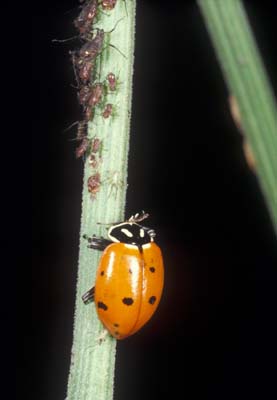
Adult convergent lady beetle,
Hippodamia convergens.
(Photographer: James Castner, University
of Florida)
Adult males and females of the same species are similar in appearance. Adults are usually 0.5 to 0.6 cm in length. Lady beetles are oval-shaped beetles with hardened forewings that can be red, orange, black, or brown in color. The forewings of lady beetles may or may not possess a number of spots. The eggs of lady beetles are spindle-shaped and about 1 mm in length. The larvae of many species are alligator-like in appearance and have three pairs of legs. The shape and color of lady beetle larvae vary. Larvae range from 0.5 cm to 2.5 cm in length.
The life cycle of a lady beetle depends on its food supply, temperature and humidity. A typical time frame would be three to four weeks. The eggs are usually laid near a food source (such as aphids and mites) during the spring. A female lady beetle can lay anywhere from 50 to 300 eggs. These eggs hatch in three to five days. The larvae emerge from their eggs in early to mid-spring. They can wander up to 12 meters in search of prey. The larvae usually feed for two weeks and then pupate. Adults emerge in about seven to 10 days.
Lady beetles are found on many different types of flowering plants and crop vegetation throughout the United States. Lady beetles feed on aphids, scale insects, mealybugs, spider mites, and some insect eggs, such as those of the Colorado potato beetle and European corn borer.
Images
To save the Web-optimized images shown below to your hard drive:
|
Click to access Display and Print quality images. |
|
Click to access Display and Print quality images. |
|
Click to access Display and Print quality images. |
|
Click to access Display and Print quality images. |
|
Click to access Display and Print quality images. |
|
Click to access Display and Print quality images. |
|
Click to access Display and Print quality images. |
|
Click to access Display and Print quality images. |
|
Click to access Display and Print quality images. |
|
Click to access Display and Print quality images. |
|
Click to access Display and Print quality images. |
|
Click to access Display and Print quality images. |
|
Click to access Display and Print quality images. |
|
Click to access Display and Print quality images. |
|
Click to access Display and Print quality images. |